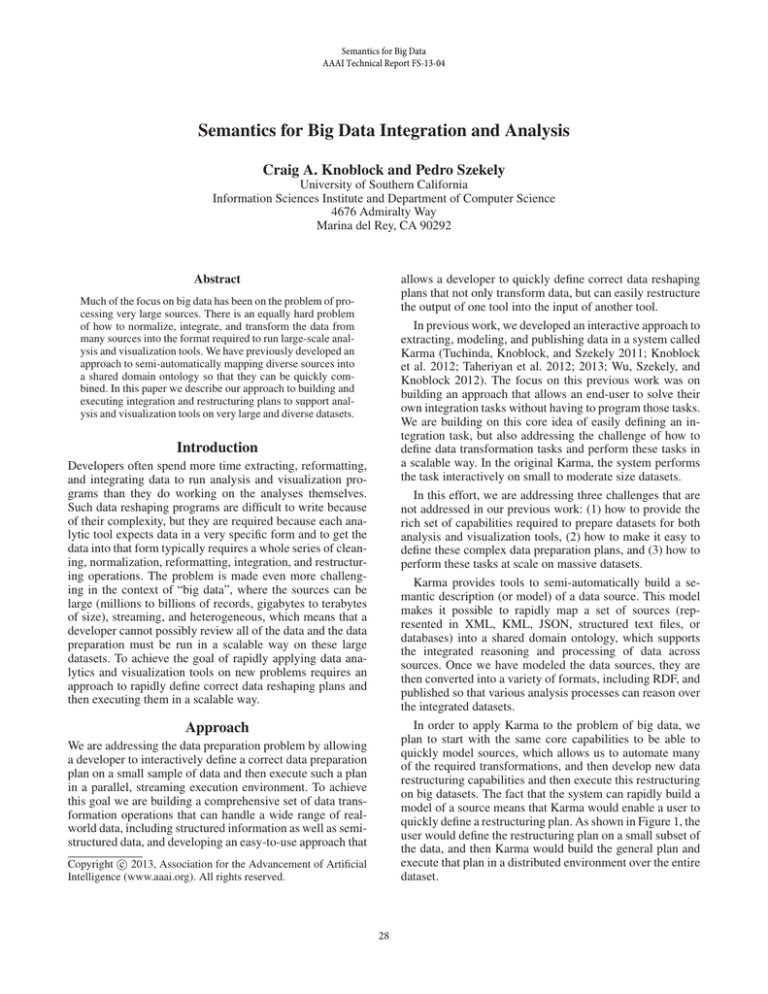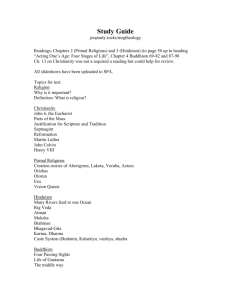
Semantics for Big Data
AAAI Technical Report FS-13-04
Semantics for Big Data Integration and Analysis
Craig A. Knoblock and Pedro Szekely
University of Southern California
Information Sciences Institute and Department of Computer Science
4676 Admiralty Way
Marina del Rey, CA 90292
Abstract
allows a developer to quickly define correct data reshaping
plans that not only transform data, but can easily restructure
the output of one tool into the input of another tool.
In previous work, we developed an interactive approach to
extracting, modeling, and publishing data in a system called
Karma (Tuchinda, Knoblock, and Szekely 2011; Knoblock
et al. 2012; Taheriyan et al. 2012; 2013; Wu, Szekely, and
Knoblock 2012). The focus on this previous work was on
building an approach that allows an end-user to solve their
own integration tasks without having to program those tasks.
We are building on this core idea of easily defining an integration task, but also addressing the challenge of how to
define data transformation tasks and perform these tasks in
a scalable way. In the original Karma, the system performs
the task interactively on small to moderate size datasets.
In this effort, we are addressing three challenges that are
not addressed in our previous work: (1) how to provide the
rich set of capabilities required to prepare datasets for both
analysis and visualization tools, (2) how to make it easy to
define these complex data preparation plans, and (3) how to
perform these tasks at scale on massive datasets.
Karma provides tools to semi-automatically build a semantic description (or model) of a data source. This model
makes it possible to rapidly map a set of sources (represented in XML, KML, JSON, structured text files, or
databases) into a shared domain ontology, which supports
the integrated reasoning and processing of data across
sources. Once we have modeled the data sources, they are
then converted into a variety of formats, including RDF, and
published so that various analysis processes can reason over
the integrated datasets.
In order to apply Karma to the problem of big data, we
plan to start with the same core capabilities to be able to
quickly model sources, which allows us to automate many
of the required transformations, and then develop new data
restructuring capabilities and then execute this restructuring
on big datasets. The fact that the system can rapidly build a
model of a source means that Karma would enable a user to
quickly define a restructuring plan. As shown in Figure 1, the
user would define the restructuring plan on a small subset of
the data, and then Karma would build the general plan and
execute that plan in a distributed environment over the entire
dataset.
Much of the focus on big data has been on the problem of processing very large sources. There is an equally hard problem
of how to normalize, integrate, and transform the data from
many sources into the format required to run large-scale analysis and visualization tools. We have previously developed an
approach to semi-automatically mapping diverse sources into
a shared domain ontology so that they can be quickly combined. In this paper we describe our approach to building and
executing integration and restructuring plans to support analysis and visualization tools on very large and diverse datasets.
Introduction
Developers often spend more time extracting, reformatting,
and integrating data to run analysis and visualization programs than they do working on the analyses themselves.
Such data reshaping programs are difficult to write because
of their complexity, but they are required because each analytic tool expects data in a very specific form and to get the
data into that form typically requires a whole series of cleaning, normalization, reformatting, integration, and restructuring operations. The problem is made even more challenging in the context of “big data”, where the sources can be
large (millions to billions of records, gigabytes to terabytes
of size), streaming, and heterogeneous, which means that a
developer cannot possibly review all of the data and the data
preparation must be run in a scalable way on these large
datasets. To achieve the goal of rapidly applying data analytics and visualization tools on new problems requires an
approach to rapidly define correct data reshaping plans and
then executing them in a scalable way.
Approach
We are addressing the data preparation problem by allowing
a developer to interactively define a correct data preparation
plan on a small sample of data and then execute such a plan
in a parallel, streaming execution environment. To achieve
this goal we are building a comprehensive set of data transformation operations that can handle a wide range of realworld data, including structured information as well as semistructured data, and developing an easy-to-use approach that
c 2013, Association for the Advancement of Artificial
Copyright Intelligence (www.aaai.org). All rights reserved.
28
Figure 1: A user would build a data restructuring plan on a sample of the data; Karma would execute the plan at scale
A Detailed Example
In general, users would build combined datasets to process them using appropriate analysis and visualization tools,
as shown in Figure 2. We illustrate how a user would visualize their combined dataset using Cytoscape. First, the user
would select Cytoscape from the Karma library of tools.
Because this tool would be in the Karma library, it would
have a service model that specifies the semantics and syntax of the inputs and outputs. Cytoscape is a network visualization tool, so its model would specify that it needs a
dataset containing edges that connect vertices. To invoke Cytoscape on the combined PharmGKB source, the user would
need to map the classes in the PharmGKB model to the
classes in the Cytoscape model. By leveraging the structure
of the ontologies and learning from previous uses of the tool,
Karma would propose mappings that users can adjust using
an interactive user interface (similarly to how today’s Karma
semi-automatically generates models of sources). The service model would also specify how to generate the input files
and how to invoke the tool.
Users would design and test the process interactively, on
a small data sample, and then save a plan that the system
would use to perform all the steps in batch. Figure 2 does
not illustrate it, but the service models would also include a
model of the outputs. This means that the outputs would not
be just files, but modeled datasets that researchers can publish and share with others without having to expend additional effort to annotate them with metadata. These datasets
would be ready to augment the library of datasets that the
whole community can use.
We envision using Karma to create general integration
pipelines by demonstrating them to Karma on specific subsets of their data. A user would do this interactively by working in a graphical user interface to gather, combine and process data, working with a small sample so that they can
see the results step by step. After demonstrating the desired
steps, Karma saves a general script that can be easily modified and can be executed in batch mode on larger datasets.
Figure 2 illustrates the process. Here, the user gathers
data from several bioinformatics data sources, KEGG and
PharmGKB, and downloads the data into Karma. Because
these sources are part of Karma’s library, the system automatically imports the data and shows the source model of
the data. The model for the KEGG data is simple, as the
data just contains attributes of genes. However, the model
for the PharmGKB data is more sophisticated as it contains
data about pathways, genes, drugs, and diseases. The model
shows how the various elements are related using the terminology defined in the ontology for these sources. After
the gathering phase, users can easily combine the data in a
semantically consistent way. In the example, the user combines the datasets based on the Gene class that is present in
the models of both sources. This allows users to easily incorporate attributes from KEGG into the dataset gathered from
PharmGKB.
If Karma did not already have a model of a specific
source, it would attempt to build one automatically. Karma
automatically suggests mappings for each data column to
classes and properties in the ontology. These mappings are
based on learned models of semantic types that the system
encountered previously. For the table of data from PharmGKB, Karma would automatically suggest that the AccessionId column is mapped to the pharmGKBId of Pathway
because it has seen similar data before. Whenever suggestions are incorrect or missing, users can click on the black
circles to correct them. Most importantly, Karma builds
the model that ties the columns together. In this example,
Karma would suggest using classes such as Disease, Pathway, Gene, and Drug and suggest the properties to connect
these classes. When the suggestions are incorrect, users can
change them by selecting the appropriate classes and properties from the ontology (user adjustments are shown in blue).
Karma includes a learning module that learns from these adjustments, iteratively improving its accuracy the more it is
used with similar data (Taheriyan et al. 2013).
Related Work
Developers today approach data preparation either by laboriously defining and writing programs or by using existing
data warehousing tools, neither of which provides the flexibility to cope with diverse and changing data sources, nor
the scalability to cope with large, streaming data. We have
developed an innovative approach to easily define data integration plans in Karma. It already addresses several data
reshaping challenges, and we are now working to add the
flexibility and richness required to rapidly apply data analysis and visualization tools to new datasets.
The most closely related work to this effort is the recent work on GoogleRefine1 and DataWrangler (Kandel et
al. 2011). Both systems provide good support for solving a
small part of the data reshaping problem that we address in
1
29
http://code.google.com/p/google-refine/
Analysis Workflow
LabKey
Cytoscape
cMonkey
Inferrelator
Gaggle
Gather
Gather
Combine
Library
model
Map
model
Network Difussion
model
Process
Figure 2: Example of how a user would create a data integration plan that transforms and restructures messy raw data to
visualize it using a visualization tool called Cytoscape
Karma. They support structured and semi-structured data,
but lack support for hierarchical data (e.g., XML, JSON,
RDF). Both are focused on single datasets, lacking support for integrating multiple datasets. Data Wrangler is a
browser-based tool with no server component, so it is limited to datasets of a few thousand records. Google Refine
allows users to define new operators using Javascript, making it more powerful, but harder to use. It has a server component so it can support large datasets, but has no support
for streaming data or parallelization. There is also an extension to Google Refine that makes it possible to publish data
in RDF with respect to a domain model (Maali, Cyganiak,
and Peristeras 2012), but the mapping to the domain model
is defined manually. Neither system has explicit models to
capture the input/output requirements of other tools. They
provide a set of useful operators, but without the seman-
tic models users receive no guidance on what operations to
use to reshape data to satisfy the requirements of the toolkit
components they want to invoke.
Other related work includes the data warehouse tools
(e.g., Informatica, IBM DataStage, Oracle Data Integrator,
and Talend) that are designed to process very large datasets,
but all of these tools require a centralized data repository and
require significant manual effort to define the ETL rules to
set up this repository (Inmon 2005). There is recent work to
to scale these systems to petascale data warehouses, such as
the recent system developed by Facebook, called Hive (Thusoo et al. 2010), but like other data warehouse tools, this tool
still requires significant effort to define the integrated data
warehouse.
30
Discussion
cloud. In Proceedings of the 11th International Semantic
Web Conference (ISWC 2012).
Taheriyan, M.; Knoblock, C. A.; Szekely, P.; and Ambite,
J. L. 2013. A graph-based approach to learn semantic descriptions of data sources. In Proceedings of the 12th International Semantic Web Conference (ISWC 2013).
Thusoo, A.; Sarma, J. S.; Jain, N.; Shao, Z.; Chakka, P.;
Zhang, N.; Antony, S.; Liu, H.; and Murthy, R. 2010. Hive a petabyte scale data warehouse using hadoop. In Proceedings of the 26th International Conference on Data Engineering (ICDE), 996–1005.
Tuchinda, R.; Knoblock, C. A.; and Szekely, P. 2011. Building mashups by demonstration. ACM Transactions on the
Web (TWEB) 5(3).
Wu, B.; Szekely, P.; and Knoblock, C. A. 2012. Learning
data transformation rules through examples: Preliminary results. In Ninth International Workshop on Information Integration on the Web (IIWeb 2012).
We believe the approach presented here will dramatically
reduce the time to construct data reshaping plans, improve
their reliability, and execute them at scale. This will enable
developers to rapidly and correctly prepare data for analysis and visualization tools and link the output of one tool to
the input of the next, all within the big data environment.
This, in turn, will allow developers to focus on the analysis
workflows, trying different tools, different parameters, etc.
in order to optimize the analyses. Today, there are no tools
that attempt to solve this problem. As described above, the
closest partial solution to this challenge of transforming and
restructuring data considers only static data, and requires either manual programming, tools such as Google Refine with
only interactive cleaning, or relatively inflexible data warehouse products. None of these systems provide an end-toend solution to the problem and for the parts of the problem
that they do solve, they do not offer an easy-to-use approach
to define data restructuring plans for processing very large
or streaming datasets.
One area of future research is how to build the data reshaping plans without access to all of the data. For both very
large datasets and streaming data, it is not feasible to consider all of the data to build the data reshaping plans. So the
challenge is how to decide which portion of the data to examine and how to decide when the system has seen enough
of the data to build correct and reliable data reshaping plans.
Acknowledgements
This research is based upon work supported in part by
the National Science Foundation under award number IIS1117913. The views and conclusions contained herein are
those of the authors and should not be interpreted as necessarily representing the official policies or endorsements, either expressed or implied, of NSF or any person connected
with them.
References
Inmon, W. H. 2005. Building the data warehouse. Wiley.
Kandel, S.; Paepcke, A.; Hellerstein, J.; and Heer, J. 2011.
Wrangler: interactive visual specification of data transformation scripts. In Proceedings of the 2011 annual conference on Human factors in computing systems, CHI ’11,
3363–3372.
Knoblock, C. A.; Szekely, P.; Ambite, J. L.; ; Goel, A.;
Gupta, S.; Lerman, K.; Muslea, M.; Taheriyan, M.; and
Mallick, P. 2012. Semi-automatically mapping structured
sources into the semantic web. In Proceedings of the Extended Semantic Web Conference.
Maali, F.; Cyganiak, R.; and Peristeras, V. 2012. A publishing pipeline for linked government data. In Simperl,
E.; Cimiano, P.; Polleres, A.; Corcho, O.; and Presutti, V.,
eds., The Semantic Web: Research and Applications, volume
7295 of Lecture Notes in Computer Science. Springer Berlin
Heidelberg. 778–792.
Taheriyan, M.; Knoblock, C. A.; Szekely, P.; and Ambite,
J. L. 2012. Rapidly integrating services into the linked data
31





